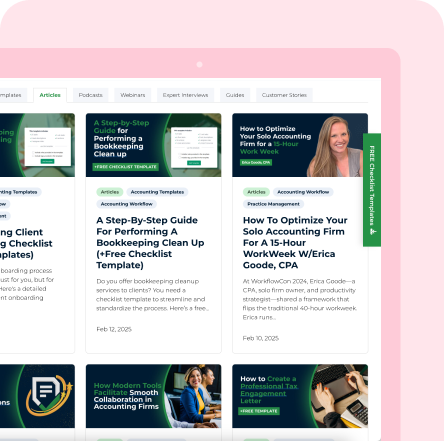If you work with clients under an accrual-based system, you know that timing is everything. The revenue recognition principle helps you decide when to record income so your financial statements truly reflect business performance. Without it, you could show profits long before you’ve earned them or delay revenue that should already be recognized.
In accrual-based accounting, accuracy depends on matching income to the period in which it’s earned, not when cash hits the bank. The revenue recognition principle gives you that structure. It ensures your firm or your client’s business reports revenue in a consistent, transparent way that aligns with GAAP (Generally Accepted Accounting Principles).
This consistency matters. It helps investors, regulators, and internal stakeholders trust the numbers they see. It also keeps your firm compliant, reduces audit risks, and supports clearer decision-making for both you and your clients.
What Is the Revenue Recognition Principle?
The revenue recognition principle is a key accounting rule that determines when you should record revenue in your books. Under this principle, you record income when it is earned, not when cash is received. That means revenue is recognized once you’ve delivered a product or completed a service, even if payment comes later.
This principle forms the foundation of accrual accounting, where transactions are recorded as they occur rather than when money changes hands. It contrasts with cash accounting, where you only record revenue when you actually receive payment.
If you work with product-based clients, you’ll recognize revenue when goods are shipped or ownership passes to the buyer. For service-based clients, you’ll recognize revenue as the work is performed or when specific milestones are met.
Applying the revenue recognition principle helps you match income to the correct period, giving you and your clients a clearer picture of business performance. It also strengthens compliance with GAAP and builds confidence in the accuracy of every report you prepare.
The Five-Step Model (ASC 606 Framework)
To create consistency across industries and eliminate confusion around when and how to recognize revenue, the Financial Accounting Standards Board (FASB) introduced ASC 606: Revenue from Contracts with Customers. This framework provides a single, principles-based model that applies to all entities, whether your firm serves product-based or service-based clients. This five-step model guides how you should recognize revenue from customer contracts.
1. Identify the contract with a customer
Start by confirming that a valid and enforceable contract exists. The agreement should clearly define the rights and obligations of both parties, outline the payment terms, and specify what is being sold or delivered. Without a valid contract, you don’t have the foundation for recognizing revenue. For example, a signed purchase order, a formal service agreement, or even an electronic acceptance can qualify as a contract if it creates enforceable rights and obligations.
2. Identify the performance obligations in the contract
Once you have the contract, determine what goods or services you’ve promised to deliver. Each distinct promise represents a performance obligation, and revenue must be recognized separately for each one. For example, if your client sells software and provides ongoing support, you’ll treat those as two different obligations. Getting this right helps you recognize revenue in the right period for each deliverable.
3. Determine the transaction price
Next, calculate the total consideration your client expects to receive. This could include fixed fees, variable components like commissions or discounts, and even non-cash considerations. As their accountant, you’ll need to estimate this total based on contract terms and reasonable expectations, something auditors and regulators will expect to see documented.
4. Allocate the transaction price to the performance obligations
If there are multiple obligations, allocate the total contract price across them based on their standalone selling prices. This step ensures each product or service is recognized proportionally to its true value. For instance, when a client bundles hardware with maintenance, you’ll split the total contract price between both obligations based on how each is normally sold on its own.
5. Recognize revenue when (or as) the entity satisfies a performance obligation
Finally, recognize revenue as your client fulfills each performance obligation. That could be over time, such as during a long-term construction project, or at a specific point, like when goods are delivered to the customer. The key is to match recognition to the moment control passes, not the moment cash comes in. Your responsibility is to assess when control passes, then recognize revenue in that same period. This ensures your reports reflect real performance rather than the timing of cash inflows.
Practical Examples of Revenue Recognition
Sometimes the best way to understand the revenue recognition principle is to see it in action. Below are a few examples that show how it works for different types of businesses.
Example 1: Product Sale
Suppose one of your clients sells a batch of products in January, but the customer pays in February. Under the revenue recognition principle, you record the revenue in January, the month the goods were delivered and ownership transferred. The cash may arrive later, but the earning activity happened in January, so that’s when you recognize it.
Example 2: Service-Based Business
Imagine a consultant client who receives full payment in March for a project that will be completed in April. You don’t recognize the revenue when the payment hits the account. Instead, you record it in April, once the service is delivered. This approach aligns income with performance and keeps the financials compliant with accrual-based reporting.
Example 3: Subscription-Based Business
If you work with SaaS clients, this one will sound familiar. A software company receives an annual subscription fee upfront in January. Rather than recording the full amount right away, you spread the revenue evenly, monthly throughout the year, as the service is provided. This shows a more accurate reflection of recurring performance instead of a one-time spike.
Example 4: Long-Term Project
Construction and engineering firms often recognize revenue over time. For instance, a client building a commercial property over twelve months can recognize revenue progressively as milestones are met or as the percentage of work completed increases. This method gives stakeholders a real-time view of progress and profitability instead of waiting until the project ends.
Each example underscores the same principle: revenue should reflect when your client earns it, not when they collect payment. By applying this consistently, you help your clients maintain accurate records, satisfy auditors, and present a truer picture of financial performance.
Why Is the Revenue Recognition Principle Important?
The revenue recognition principle does more than set a rule for timing, it safeguards the accuracy, transparency, and credibility of your financial reporting. When you apply it consistently, you strengthen not just your clients’ books but also your firm’s professional reputation.
Let’s break down why this principle matters so much in your day-to-day work.
1. Ensures consistency in financial reporting
When you follow the same standards for recognizing revenue, your financial statements become consistent and comparable across periods. This consistency helps you and your clients spot real business trends instead of timing distortions caused by early or delayed recognition.
It also simplifies audits and internal reviews. Your auditors can trace revenue events back to specific contracts and obligations without confusion. That clarity not only makes compliance easier but also positions your firm as one that values accuracy and discipline in its reporting.
2. Builds trust with stakeholders
Trust is at the heart of every client relationship and every financial statement you prepare. When revenue is recognized accurately, stakeholders, from investors and lenders to boards and regulators, can rely on the numbers to tell a true story about performance.
As a firm owner or CPA, this accuracy reflects directly on your professionalism. Clients are more likely to stay loyal when they see that your reports give them a clear, honest view of their business health. It also builds your credibility with third parties who depend on your work for financial decisions.
3. Prevents manipulation of financial results
Without a clear framework like the revenue recognition principle, revenue could easily be moved from one reporting period to another to inflate results. That’s a risk no firm wants to take. By following this principle, you establish clear boundaries that prevent earnings management and protect both your firm and your clients from compliance issues.
Common Mistakes and Misapplications
Even experienced accountants can run into trouble with revenue recognition when the rules are applied inconsistently or overlooked. Here are a few common mistakes to watch for:
a. Recording revenue too early
Recognizing revenue before it is earned can distort financial results and violate the matching principle. Make sure revenue is only recorded once the earning process is complete, whether that means delivering a product or fulfilling a service obligation.
b. Using cash basis for clients who should be accrual-based
Some businesses mistakenly record revenue only when payment is received, even though they operate under GAAP. If a client’s operations or reporting requirements call for accrual accounting, switching to the proper basis ensures accuracy and compliance.
c. Ignoring contract obligations in service businesses
Service-based firms often have multiple deliverables within a single contract. Overlooking these separate performance obligations can lead to recognizing revenue too soon or too late. Breaking contracts into clear obligations helps align recognition with actual work performed.
d. Not documenting deliverables clearly in client agreements
Vague or incomplete contracts make it difficult to determine when a performance obligation is satisfied. Every agreement should clearly describe the products or services, timelines, and pricing. Strong documentation protects both your firm and your clients during audits or reviews.
Best Practices for Applying the Revenue Recognition Principle
Getting revenue recognition right takes more than just knowing the rules. It requires consistency, documentation, and team alignment. These best practices can help you stay accurate and compliant across every engagement.
i. Review client contracts carefully
Start by reading each contract in detail. Make sure the terms clearly define deliverables, performance obligations, payment timing, and transfer of control. The more specific the contract, the easier it is to apply the right recognition criteria.
ii. Standardize policies for different industries
Different industries have different revenue patterns. Standardizing how your firm handles common scenarios, such as software subscriptions, construction milestones, or product deliveries, helps reduce errors and ensures everyone applies the same principles.
With Financial Cents, you can build these standards directly into your firm’s workflows. By setting up customized templates, automated recurring tasks, and industry-specific checklists, your team follows the same process every time, no matter the client type.
iii. Train staff on GAAP requirements
Ongoing training keeps your team informed about the latest guidance under ASC 606 and GAAP. Even short refreshers or internal workshops can go a long way in maintaining compliance and confidence when reviewing financial statements.
iv. Use checklists for consistency
Checklists may seem basic, but they prevent oversights. Use them to confirm that each contract has been reviewed, every performance obligation identified, and all required documentation in place before recognizing revenue. When you combine clear documentation with consistent processes, you strengthen your firm’s credibility and make audits smoother for everyone involved.
Conclusion
The revenue recognition principle is one of the cornerstones of accrual-based accounting. It defines when revenue should be recorded, ensuring that income reflects the period in which it’s actually earned. When you apply this principle correctly, your financial statements become clearer, more consistent, and more trustworthy.
You’ve seen how it works across different business models. The key is balance: recognizing revenue accurately while keeping your workflows efficient and your team aligned.
That’s where Financial Cents can help. Our platform is built to simplify firm operations so you can focus on what matters most, delivering accurate, timely results for your clients. With tools for accounting workflow management and automation, recurring task scheduling, client and project tracking, time tracking and billing, and team collaboration, Financial Cents helps your firm stay organized and compliant without sacrificing speed or quality.
Accurate revenue recognition starts with structure. Financial Cents gives you that structure, helping you manage every engagement from start to finish with confidence.






